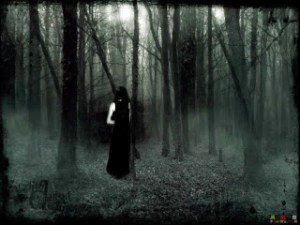Not All Roads Lead Home
October 30, 2022 Leave a comment
In truth, all through the haunted forest there could be nothing more frightful than the figure of Goodman Brown.
Before the Technicolor fairy tale of a quartet of troubled characters trekking through a foreboding forest hoping to gain what they lack from the “great and powerful” Self-Gnosis (The Wizard of OZ), there is a tale of a young man taking a similar journey. And though there is no fear of “lions and tigers and bears” in this tale, there is “What if the devil himself should be at my very elbow!”.
It seems to me that both tales are about journeys into the dark side – the nocturnal forest – to look for an esoteric mystical experience that would supply what is missing. But unlike the “There’s no place like home” heartening ending of the OZ tale, we find in the second tale that those who covenant to journey into the forest and the deepest darkest part of it, come home disillusioned and faithless.
Often, especially in our youth, we begin to question the religious beliefs and worldviews of our families, of our mentors and of those around us. We see hypocrisy around us and despise it and yet become two-faced in our own sought out experiences wrought in the dark. We then begin to take on ambivalence about evil, giving ourselves the ‘grace’ to operate in both good and evil ways. Moral relativism is that form of grace.
We tell ourselves that there are people who are restrictive, conservative and Puritanical – “They don’t know me.”. We tell ourselves that we have become too worldly-wise to be like them: “I have Jesus. I’m above all that narrow-minded out-of-date conventionalism. I’m the progressive sort.” So, we journey into the dark forest, into the deepest darkest part of the forest, and think ourselves to be impervious to whatever lurks there. With each step we tell ourselves “I am only seeking understanding”.
We give ourselves permission to investigate the dark side. We say to ourselves “I will do it just one time. Why be left out? Why not join the “communion of our race””? Thus, we journey into the night and encounter evil. And like Goodman Brown, in Nathaniel Hawthorne’s 1835 short story by the same name, we come home disillusioned, our faith destroyed.
Young Goodman Brown sets out one night to gain existential insight into good and evil. The story, set in 17th century Puritan New England, operates within the Puritan context of sin, grace and unconditional salvific election. I consider the tale an allegory, as it employs symbols starting with the names Goodman and Faith.
In the tale before us, Goodman Brown leaves his saintly wife Faith at the threshold of their home. She is wearing a pink ribbon on her cap. The pink ribbon, mentioned throughout, I read as a symbol of the admixture of purity (white) and sin (red). The color speaks to Goodman Brown’s spiritual understanding based on his Puritan beliefs and also to his rose-colored romance-based naiveté about the nature of evil.
“Poor little Faith!” thought he, for his heart smote him. “What a wretch am I to leave her on such an errand! She talks of dreams, too. Methought as she spoke there was trouble in her face, as if a dream had warned her what work is to be done tonight. But no, no; ‘t would kill her to think it. Well, she’s a blessed angel on earth; and after this one night I’ll cling to her skirts and follow her to heaven.”
With this excellent resolve for the future, Goodman Brown felt himself justified in making more haste on his present evil purpose. He had taken a dreary road, darkened by all the gloomiest trees of the forest, which barely stood aside to let the narrow path creep through, and closed immediately behind. It was all as lonely as could be; and there is this peculiarity in such a solitude, that the traveller knows not who may be concealed by the innumerable trunks and the thick boughs overhead; so that with lonely footsteps he may yet be passing through an unseen multitude.
As Goodman sets out, he does so under the cover of night and the cover of assumption: as a Puritan, Goodman Brown considers himself one of the elect. He carries with him a Puritan/Calvinist ‘good hands’ insurance card – the doctrine of predestination. He doesn’t leave home without it. And, as you read above, Goodman assumes that his association with the right people – his wife Faith in particular and the town’s good church folk in general – that he will follow them to the heavenly home. Goodman Brown goes out into the portentous night feeling safe and secure from all alarms. But his predetermined confidence quickly melts away as soon as he steps into the mysterious dark woods.
He had taken a dreary road, darkened by all the gloomiest trees of the forest, which barely stood aside to let the narrow path creep through, and closed immediately behind. It was all as lonely as could be; and there is this peculiarity in such a solitude, that the traveller knows not who may be concealed by the innumerable trunks and the thick boughs overhead; so that with lonely footsteps he may yet be passing through an unseen multitude.
Goodman’s first encounter in the woods is an old man who reminds him of his goodly grandfather. The old man appears to be waiting for Goodman. He says, “You are late, Goodman Brown.” Goodman replies “Faith kept me back awhile”.
Though the old man appears similar to Brown in many pedestrian ways the old man also appears to have “an indescribable air of one who knew the world”. And there’s something else Goodman notices and tries to explain away.
But the only thing about him that could be fixed upon as remarkable was his staff, which bore the likeness of a great black snake, so curiously wrought that it might almost be seen to twist and wriggle itself like a living serpent. This, of course, must have been an ocular deception, assisted by the uncertain light.
It is clear to the reader that the old man is the devil who is supported by the serpent staff, He does his best to entice Goodman Brown down the road to what is later called “the communion of your race” where he will learn of the “secret deeds” of his fellow townsfolk and see hypocrisy countenanced.
Goodman balks, claiming to be one of a breed of men who is above the riff-raff.
“Too far! too far!” exclaimed the goodman, unconsciously resuming his walk. “My father never went into the woods on such an errand, nor his father before him. We have been a race of honest men and good Christians since the days of the martyrs; and shall I be the first of the name of Brown that ever took this path and kept—”
Goodman’s journey away from faith is stop and go as wrestles with the temptation of going on. He encounters something he initially resists and uses the honor of his good name and of those before him as a reason to rethink things before giving on to going on. But, he doesn’t use his faith as a shield and so bends in to temptation. He continues his journey with the old man’s urging.
The old man tries to persuade Goodman to get up and continue. He does so by using Goodman’s own argument. The old man conjures up a kinship with men like Goodman. He lies about having personal knowledge and acquaintance of Goodman’s family. He then speaks of townsfolk – deacons and those in power – as personal references. He cajoles Goodman to continue their ‘association’ by journeying on.
Goodman Brown once considered himself impervious to all the devil’s wiles. After all he was one of the elect and associated with the right people. But each step he took in the wrong direction away from faith weakened his resolve. His compromises were reinforced by his inordinate curiosity. He continues his journey into the deepest darkest part of the forest and sees what the “communion of our race” so desires, “that the good shrank not from the wicked, nor were sinners abashed”.
There are several interpretations and critiques of the story. Some will say that Hawthorne is pointing out the hypocrisy of a society that prides itself on its high moral and civic standing and makes outcasts of those who do not live up to its standards. Other interpreters go out on a dark forest limb with their construal:
Modern critics have interpreted “Young Goodman Brown” in many ways. The story as a critique of society stands out to some. To psychologically inclined readers, Brown journeys into the psyche. The village represents the superego, whereas the forest and darkness become equivalents of the Freudian id. The entire story becomes a portrait of one human mind that discovers the usually suppressed and disquieting reality of animal instinct
The story’s symbols lend its meaning to a wide audience and to many interpretations. As you read it you will have your own takeaway. I consider it an allegory or parable about assumptions, hypocrisy and the lure of evil to pull one away from one’s home base of faith toward the “reality of animal instincts”.
The story doesn’t tell us Brown’s motives other than “present evil purpose” Conjecture would lead us to think that young Goodman Brown had become questioning about evil and the devil even though he lived surrounded by strict warnings against both in Puritan village. One gets the sense that Brown goes out by himself to just stick his nose in on evil for the sake of understanding the world he lives in and perhaps the fear of evil inculcated in him by his upbringing.
I have provided some of my take on Young Goodman Brown and some excerpts from the story with the hope that you will read the short story (it should take about fifteen minutes). I invite you to consider what road you are taking when you want to stick your nose in on evil. Consider where it leads and what you will encounter. And, where it will lead you. This road does not lead home.
We are told in Scripture to “test the spirits” so that we may know what is good and true and from God. That is not what is going on in Young Goodman Brown. Rather, this a young man who leaves faith behind and takes a walk on the wild side and ends up at a satanic ritual. His road did not lead back home to faith. It led to nihilism and despair and the resolve to no longer exist.
In truth, all through the haunted forest there could be nothing more frightful than the figure of Goodman Brown. On he flew among the black pines, brandishing his staff with frenzied gestures, now giving vent to an inspiration of horrid blasphemy, and now shouting forth such laughter as set all the echoes of the forest laughing like demons around him. The fiend in his own shape is less hideous than when he rages in the breast of man. Thus sped the demoniac on his course, until…
Well, you’ll just have to read the story:

